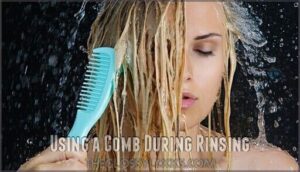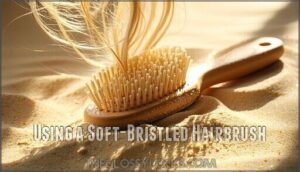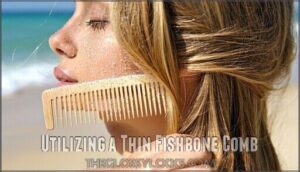This site is supported by our readers. We may earn a commission, at no cost to you, if you purchase through links.
 To get sand out of hair, shake your hair upside down first to remove loose grains.
To get sand out of hair, shake your hair upside down first to remove loose grains.
Then rinse with lukewarm water while gently massaging your scalp. Apply a generous amount of conditioner and work it through with your fingers or a wide-tooth comb.
For stubborn sand, try applying baby powder to dry hair—it helps loosen trapped grains. You can also use a blow dryer on cool setting to blast away remaining particles.
Prevent future sandy situations by wearing a hat or tying your hair up at the beach. The right technique can save you from that gritty feeling that seems to follow you home long after beach day ends, and help you avoid the hassle of removing sand from your hair with a blow dryer.
Table Of Contents
- Key Takeaways
- Removing Sand Easily
- How to Get Sand Out
- Water Based Methods
- Effective Sand Removal
- Conditioner and Care
- Advanced Removal Tools
- Preventing Sand Accumulation
- Removing Stubborn Sand
- Sand Removal Techniques
- Final Sand Removal Tips
- Frequently Asked Questions (FAQs)
- How do you get sand out of your hair fast?
- How to get sand out of your head?
- How to get sand out of a child’s scalp?
- How to prevent sand in hair at the beach?
- Can oily hair attract more sand?
- How to protect toddler’s hair from sand?
- Does sand cause hair damage or breakage?
- Are there special tools for sand removal?
- How to remove sand from dreadlocks?
- Does salt water affect sand removal effectiveness?
- Conclusion
Key Takeaways
- Start by flipping your hair upside down and shaking it vigorously to remove loose sand particles before washing.
- Use lukewarm water with generous amounts of conditioner, then comb through your hair with fingers or a wide-tooth comb to dislodge stubborn grains.
- For extremely persistent sand, apply baby powder to dry hair to absorb moisture and help release trapped particles, or use a blow dryer on cool setting aimed at your roots.
- Prevent sand accumulation by wearing a hat, tying your hair up, or applying leave-in conditioner before heading to the beach.
Removing Sand Easily
When sand gets tangled in your hair after a day at the beach, don’t worry—it’s easy to shake it out.
With a few simple moves like flipping your hair upside down and using your fingers to comb through, you’ll be sand-free in no time, and this can be achieved by making a few simple moves.
Gently Shaking Hair
A quick pre-wash shake can be your sandy hair’s best friend.
Tilt your head, let gravity assist, and shake hair vigorously to loosen sand near the roots.
Flip, shake, repeat—it’s like giving your hair a little beach vacation before the shampoo.
- Tilt head forward for gravity assistance.
- Shake hair firmly from roots to tips.
- Flip hair upside down for root loosening.
- Perform quick shakes for sand dislodgement.
- Follow with your favorite sand removal methods to achieve complete sand removal.
Using Fingers to Comb
Finger combing is your secret weapon when tackling sand removal.
By gently massaging your scalp and working through strands, you can dislodge sand stuck in hair without tugging.
Slide fingers from roots to ends for smooth hair detangling.
Root manipulation helps with stubborn grains.
Finished? Check this table of benefits:
| Action | Benefit | Pro Tip |
|---|---|---|
| Scalp massage | Sand dislodgement | Go slow, use fingertips! |
| Root manipulation | Stubborn grains moved | Part hair into sections |
| Gentle detangling | Reduced breakage | Combine with conditioner |
| Sand removal | Clean strands | Tilt head while combing! |
| Hair detangling | Tangle-free locks | Start at ends, go up! |
Flipping Hair Upside Down
To tackle sand stuck in hair, flip your hair upside down and let gravity lend a hand with a gravity-assisted shake.
This position improves scalp access and loosens root sand removal effortlessly. Shake your head side to side for better results.
Pair with inverted hair combing to enhance volume and sand release. It’s a smart post-beach hair tip for sand-free hair!
How to Get Sand Out
Got sand stuck in your hair after a beach day? Don’t panic—it happens to the best of us.
To remove sand without causing scalp irritation or dealing with unnecessary product buildup, start with easy steps. Shake your hair gently while tilting your head forward to let gravity work its magic. Use your fingers to comb through strands, especially near the roots.
For stubborn grains or kid-friendly methods, try these tips:
- Comb through with a wide-toothed comb to loosen trapped sand.
- Massage your scalp lightly to dislodge grains hiding near the surface.
- Dust baby powder onto dry hair, then shake it out to absorb moisture and help the sand fall free.
Similarly, peanut butter works to remove other sticky substances. Keep these beach hair tips handy, and you’ll get sand out in no time!
Water Based Methods
Water can be your best friend in the matter of clearing sand out of your hair.
With a little rinsing and massaging, you’ll have your locks feeling clean and comfortable in no time.
Rinsing With Lukewarm Water
Using lukewarm water is a game-changer for beach hair. Let the water flow through your hair, focusing on the roots and ends.
Its warmth helps sand settle and rinse away without stripping natural oils. Pair it with a scalp massage for thorough cleaning and easy sand removal.
Don’t rush—gentle squeezing removes lingering grains and preps for conditioner. This method helps with natural oil preservation, which is beneficial for hair health.
Massaging Water Into Hair
Massaging water into your hair is a simple way to loosen stubborn sand.
Focus on scalp stimulation by gently scrubbing in circular motions, letting water circulation dislodge sand from roots to ends.
This technique helps with sand loosening and residue removal, leaving your hair feeling fresh.
Add this to your hair washing tips for easier sand removal after beach days!
Using a Comb During Rinsing
A simple way to tackle sand particles during rinsing is by combing through your hair while water runs over it.
Use a wide-toothed comb to gently detangle hair strands, starting at the ends and working upwards.
Aim the rinse direction downward with lukewarm water for better sand particle removal, this method cleans effectively and prevents tugging.
Effective Sand Removal
You don’t need to spend hours battling stubborn sand in your hair—simple tricks can make a big difference.
From dunking your hair in water to using a blow dryer on a cool setting, these methods are quick and effective.
Submerging Hair in Water
Submerging your hair in water is an effective way to remove sand.
Sand settles naturally, while floating hair lets water rinse every strand.
Try these tips for sand-free hair:
- Lay in a tub and swish your hair in lukewarm water.
- Soak hair in a pool or basin to loosen grains.
- Finish with effective rinsing.
Allowing Sand to Settle
Let gravity influence sand removal naturally.
When hair is submerged in water, let sedimentation time do the work—sand density causes particles to sink to the bottom.
Gently swish your hair or brush off any loosened grains.
This natural separation lets water immersion become a hassle-free method.
Relax, enjoy the break, and watch as sand in hair gradually disappears with natural ease.
Using a Blow Dryer on Cold
Cold air benefits your hair while tackling sand removal.
Use a blow dryer on a cold setting to gently blow away stubborn grains. This method prevents hair damage compared to heat.
Aim the dryer at your scalp, pointing downward to loosen sand. For trickier spots, combine this technique with alternative methods like brushing or combing.
It’s a breeze!
Conditioner and Care
Conditioner is your best friend in the case of loosening stubborn sand and restoring softness to your hair.
By massaging it in and letting it sit, you’ll make sand removal easier and give your scalp a soothing break.
Applying Generous Conditioner
After floating that last stubborn sand out with water, it’s time to apply conditioner generously. This step doesn’t just soften your strands; it helps remove sand for good.
- Use a hydrating conditioner and coat your hair thoroughly.
- Focus on areas near your scalp where sand loves to hide.
- Don’t skip a scalp massage—it’s relaxing and effective! Overdoing it, however, can lead to hair weighed down.
Distributing Conditioner Evenly
Start with a dollop of conditioner—too much, and you’ll look like a science experiment.
Rub it between your palms, then apply evenly from roots to tips.
Use a wide-tooth comb to detangle and guarantee coverage.
Avoid clumps by sectioning your hair as needed.
| Step | Action |
|---|---|
| 1. | Rub conditioner in your hands. |
| 2. | Apply from roots to ends. |
| 3. | Comb hair to detangle knots. |
| 4. | Guarantee even coverage. |
| 5. | Section hair for precision. |
Massaging Scalp for Relaxation
Massaging your scalp can make the sand removal process relaxing and effective. Use gentle, circular motions to focus on pressure points, improving circulation while loosening stubborn sand particles.
Massaging your scalp transforms sand removal into a soothing ritual, easing stubborn grains while boosting circulation for refreshed, beach-ready hair.
Pair the massage with essential oils for added hair care benefits. Dim the lights, play some relaxation music, and treat yourself to a mini spa moment while achieving sand-free hair.
- Scalp Massage Benefits: Boosts circulation and removes sand.
- Massage Technique Variety: Circular, tapping, or kneading motions work best.
- Pressure Point Focus: Target areas near roots and scalp edges for effective cleaning.
- Essential Oil Use: Lavender or tea tree oils soothe and nourish.
- Relaxation Music Pairing: Soft tunes turn hair cleaning into self-care.
Advanced Removal Tools
When regular methods don’t cut it, advanced tools can make sand removal from your hair a breeze.
With the right brush, a bit of baby powder, or a fine-toothed comb, you’ll handle those stubborn grains in no time.
Using a Soft-Bristled Hairbrush
After conditioning, grab a soft-bristled hairbrush to tackle stubborn sand particles.
The right brush bristle type gently removes sand while protecting strands. Use slow, steady brushing techniques, starting at the ends and working up.
This stimulates your scalp and detangles hair without hassle. A good option includes a brush with gentle bristles available.
Don’t forget brush maintenance—clean bristles to avoid redepositing sand during future hair care sessions, which is an important part of overall hair care.
Applying Baby Powder to Absorb Moisture
After gently brushing with a soft-bristled hairbrush, grab some baby powder for a clever trick to remove sand particles.
Lightly sprinkle it on dry hair, focusing on the scalp, and use a gentle scalp massage technique to loosen those stubborn grains.
The moisture absorption rate of baby powder helps lift grit, making it an effective method for removing sand.
Consider exploring baby powder options for your hair, and then rinse thoroughly to prevent powder residue, leaving sand-free hair with a gentle finish, thanks to the baby powder.
Utilizing a Thin Fishbone Comb
Using a thin fishbone comb is a smart way to remove sand, especially for short hair or sensitive scalps.
For success:
- Gently detangle by combing small sections from ends to roots.
- Focus on areas where sand collects, like near the scalp.
- Work slowly to avoid pulling hair.
Consider using one to address scalp and hair needs to achieve sand-free hair and meet your hair needs.
- Clean the comb often to keep sand-free hair achievable.
Preventing Sand Accumulation
You can keep sand out of your hair by taking a few simple precautions before hitting the beach.
Wearing a hat, tying your hair up, or using a leave-in conditioner can save you from an afternoon of scrubbing later.
Wearing a Hat or Tieing Hair
Keeping sand out of your hair starts with smart preventive measures.
A sun hat offers hair protection and doubles as sun protection for your scalp.
Prefer something stylish, hair ties can keep your locks secured, reducing exposure to sand during beach activities.
These simple style options also protect your hair and make beach days more enjoyable.
Applying Leave-in Conditioner
A small dollop of leave-in conditioner creates a powerful protective barrier against pesky sand.
Before heading to the beach, comb through a hydration boost of leave-in conditioner from roots to ends.
You’ll enjoy detangling benefits while preventing sand from sticking to your strands.
For sand-free hair, select lightweight products that won’t attract grit.
Apply every few hours, especially after swimming, then use your hairbrush for easy post-beach styling to maintain a hydration boost.
Using a Sunbed Instead of Lying on Sand
After applying leave-in conditioner, consider a smart beach strategy: opt for a sunbed instead of sprawling directly on the beach.
This simple switch dramatically reduces sand accumulation in your hair while still enjoying those sunny rays.
For maximum sand-free hair during your beach vacation, pair sunbed use with a hat and non-sticky UV protection spray.
Your summer hair will thank you, and you’ll spend less time washing away unwanted sandy souvenirs later!
Removing Stubborn Sand
You’ll need extra effort for those stubborn sand grains that just won’t budge from your hair after a beach day.
When regular washing isn’t enough, try repeating your shampoo routine and using a wide-toothed comb to carefully work through those sandy strands, which can be a stubborn problem.
Repeating Shampooing and Rinsing
When stubborn sand won’t budge, repeat shampooing and rinsing until you’ve won the battle. Sand persistence can be frustrating, but don’t give up after just one wash.
For effective hair cleansing when dealing with stubborn sand:
- Apply shampoo at least twice to break down any product buildup that may trap sand particles
- Increase your shampoo frequency for particularly sandy hair
- Rinse thoroughly with water between applications to confirm progress
Your scalp will thank you!
Using a Wide-Toothed Comb or Brush
After shampooing, grab a wide-tooth comb to tackle those stubborn sand particles.
The wide spaces between teeth prevent breakage while effectively removing sand. Start at your ends and work upward using a gentle detangling technique.
Wooden comb materials reduce static compared to plastic options. For extra stubborn areas, pair your widetooth comb with a soft bristle type brush to stimulate your scalp while ensuring sand-free hair.
Applying Argan Oil for Hydration
A few drops of argan oil can work wonders for your post-beach hair.
After removing sand, apply this liquid gold to damp hair, focusing on mid-lengths and ends. Rub a small amount between your palms first, then distribute evenly with a wide-tooth comb.
For deeper hydration, leave it overnight. Argan oil’s fatty acids repair damage while its vitamin E restores moisture depleted by sun and salt.
It can also help prevent styling and coloring damage by providing liquid gold benefits.
Sand Removal Techniques
You’ll find sand removal much easier when you use the right techniques for your hair type.
Whether you’re brushing out loose particles or using a high-velocity dryer, these methods will help you get back to sand-free locks in no time.
Brushing Out Loose Sand
When sand stubbornly clings to your locks, brushing offers quick relief.
Start with sectioning hair for better control. Choose the right brush types – wide-tooth combs work wonders for removing sand particles without causing knots.
Use gentle strokes from ends to roots, especially if you have scalp sensitivity. Hold sections firmly but don’t pull.
Remember, patience yields sand-free hair faster than rushing through tangled beach tips!
Using a High-Velocity Dryer
After a fun beach day, a high-velocity dryer can be your secret weapon for sand-free hair.
Set the dryer to cool and hold it about six inches from your scalp.
- Blow perpendicular to your skin for best sand removal
- Use the dryer on small sections, working from roots to ends
- Combine with gentle finger-combing for stubborn particles
- Avoid heat settings as they can make sand stick more
The steps provided are crucial for effective sand removal from hair, ensuring a sand-free experience after a beach day.
Daily Combing and Washing
Persistent combing and washing creates your best defense against stubborn sand.
For sand-free hair, use a wide-tooth comb daily to gently detangle before washing.
Choose a moisturizing shampoo that won’t strip your scalp health.
After rinsing with water, focus on washing frequency—every other day is ideal for most people.
Remember, gentle detangling from ends to roots keeps those pesky grains from making your hair their permanent vacation home, and persistent combing and gentle detangling are key to preventing sand from becoming a problem, with moisturizing shampoo also playing a crucial role.
Final Sand Removal Tips
You’ll need these final tricks when those pesky grains just won’t quit your locks.
Try combining towel drying with a quick brush-through, or ask someone to help reach those tricky spots at the back of your head for truly sand-free hair.
Drying and Brushing Sand Out
After a day at the beach, your best allies for sand-free hair are a good brush and proper drying technique.
To remove sand effectively, first let your hair dry completely – wet sand clings more stubbornly.
Then, use a soft-bristled brush, working in sections from ends to roots to avoid creating static electricity.
A sprinkle of baby powder helps absorb moisture while you comb through stubborn spots.
Towel and HV Dryer Techniques
A few well-placed towel techniques can rescue your sand-filled locks.
Gently pat hair with a microfiber towel to absorb moisture and trap sand particles.
For stubborn grains, try an HV (high-velocity) dryer on cool setting—it’ll blow away sand without heat damage.
Different hair types respond better to specific techniques: curly hair benefits from towel scrunching while straight hair handles blow drying better.
You’ll achieve sand-free hair without excessive detangling.
Seeking Assistance When Needed
While towel-drying works wonders, sometimes you need backup with those stubborn sand grains.
Don’t hesitate to ask for help when:
- Your arms tire from awkward combing angles
- Scalp sensitivity makes self-removal painful
- Limited mobility prevents thorough cleaning
- Children wiggle too much for effective sand removal
- Professional help becomes necessary for sand causing ear infections or Swimmers Ear
For persistent earaches, consider visiting a nurse practitioner at Walgreens clinics rather than struggling alone, as this can lead to more severe issues, such as Swimmers Ear.
Frequently Asked Questions (FAQs)
How do you get sand out of your hair fast?
With a million pesky grains invading your locks, try these quick fixes: Shake your hair upside down, comb through with fingers.
Rinse with water, or apply baby powder to absorb moisture before washing thoroughly.
How to get sand out of your head?
Shake your head upside down to loosen sand particles. Comb through with fingers, then rinse thoroughly with water. For stubborn grains, apply conditioner, let it sit, then rinse again completely.
How to get sand out of a child’s scalp?
While your child plays freely, sand lurks quietly in their hair.
Submerge their head in water, letting sand sink naturally.
Then wash with shampoo, and use a wide-tooth comb to remove any stubborn grains.
How to prevent sand in hair at the beach?
Wear a hat or tie your hair up before hitting the beach. Apply leave-in conditioner to create a protective barrier. You’ll avoid the frustrating post-beach sand removal routine entirely!
Can oily hair attract more sand?
Yes, oily hair does attract more sand.
The natural oils create a sticky surface where sand particles can easily cling.
You’ll find it harder to shake out sand from greasy strands than from clean hair.
How to protect toddler’s hair from sand?
An ounce of prevention is worth a pound of cure.
Cover your toddler’s hair with a swim cap or hat, apply leave-in conditioner as a barrier, and tie long hair up before beach trips.
Does sand cause hair damage or breakage?
Sand can act like sandpaper against your hair strands, causing friction that leads to breakage.
It’ll also dry out your hair by absorbing natural oils, making it brittle and more prone to damage.
Are there special tools for sand removal?
You’ll find several effective tools for sand removal including wide-toothed combs, fine-toothed combs, soft-bristled hairbrushes, and even blow dryers on cool settings.
Baby powder and conditioner can also help loosen stubborn sand particles, making it easier to remove them with tools like soft-bristled hairbrushes.
How to remove sand from dreadlocks?
Douse your dreadlocks with water, then use a squeeze bottle to flush each lock thoroughly.
You’ll want to gently shake your head afterward and let your dreads air-dry completely to prevent mildew.
Does salt water affect sand removal effectiveness?
Yes, salt water actually makes sand removal harder.
It increases stickiness in your hair, creating a gritty residue.
You’ll need more thorough rinsing with fresh water to effectively wash away all particles.
Conclusion
When all is said and done, knowing how to get sand out of hair can save you hours of discomfort.
Whether you choose the baby powder method, a thorough water rinse, or conditioning treatment, these techniques guarantee your beach day doesn’t follow you home.
Remember to prevent sand accumulation by wearing protective hairstyles or hats.
With these simple strategies, you’ll quickly transform gritty, uncomfortable locks back into soft, clean hair that feels like you never hit the beach, using techniques that make your hair feel like new after a beach day.

















